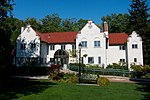Cooksville Creek

Cooksville Creek is a short stream in Mississauga, Regional Municipality of Peel in the Greater Toronto Area of Ontario, Canada. It begins near Bristol Road West and Hurontario Street and flows south to Lake Ontario at R.K McMilian Park near Lakeshore Road and Cawthra Road. The community of Cooksville is located on the west bank of the creek near Hurontario Street and Dundas Street East. The creek is surrounded mostly by residential homes and a few parks: R.K. McMilian Park Camilla Park Cooksville Park R. Jones Park Mississauga Valley Park Stonebrook Park Woodington Green Kingsbridge CommonThe drainage basin runs for 16 kilometres (9.9 mi), is about 2 kilometres (1.2 mi) wide, has a total area of 33.9 square kilometres (13.1 sq mi), and takes excess water from sanitary and storm sewers. 94% of the drainage basin is built over, and only 6% is open space.
Excerpt from the Wikipedia article Cooksville Creek (License: CC BY-SA 3.0, Authors, Images).Cooksville Creek
Waterfront Trail, Mississauga
Geographical coordinates (GPS) Address Nearby Places Show on map
Geographical coordinates (GPS)
| Latitude | Longitude |
|---|---|
| N 43.564722222222 ° | E -79.565277777778 ° |
Address
Waterfront Trail
Waterfront Trail
L5G 4B2 Mississauga
Ontario, Canada
Open on Google Maps






